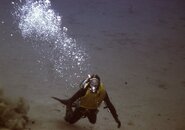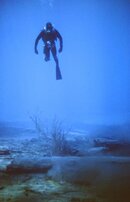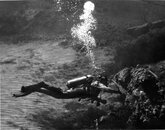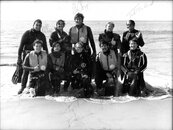There was discussion a while back on this thread of use of the "Mae West" life vest. The first photo here is of that vest. Note that the oral inflator is a very small diameter hose, which is a "push to inflate" spring-actuated valve. You pushed it onto your your teeth while holding it in one hand to inflate it. There was no overpressure relief valve, so it is assumed that you would inflate it on the surface if there was a problem. There was also a CO2 inflator mechanism for actuating it in an emergency.
The second two photos in Clear Lake, Oregon (headwaters of the McKenzie River) are of a diver properly weighted, and of myself in an Aquala dry suit (photo using my camera by Bruce Higgins). Note that weighting can easily be accomplished, even in a dry suit, without use of a BCD.
The last photo, the group shot from Santa Barbara's surf area, is of my NAUI Instructor Training Class (ITC) in 1973 (if my memory is correct). Note that we are all wearing the "Mae West" style of life vest, and not a buoyancy compensator vest. Those were forthcoming, but not at that time required. I'm the lower right-most diver in the photo.
My method of checking buoyancy in a full wet suit is to be neutrally buoyant (vertical in the water, with my eyes out of the water) on a full breath at the beginning of the dive. Exhaling initiated a descent. This made me neutrally buoyant on my return with a tank at about 500 psig (single steel 72).
Most of the buoyancy change to any wetsuit happens in the first 60 feet of water. After that, the neoprene is compressed enough that the buoyancy doesn't change much at all. So deciding on an arbitrary depth limit for diving without a BC is just that, rather arbitrary. In Clear Lake, I have taken off my weight belt, hung it on the boat's anchor line at about 60 feet, and swam around perfectly neutrally buoyant. When it came time to ascend, I simply took the weights off the line, untied the
Butterfly Knot*, and swam to the surface. But swimming at depth sans both weight belt and a BC was a magnificent experience.
SeaRat
*Every diver should know how to tie a butterfly knot (or butterfly loop) into a rope. It comes in handy in many, many circumstances.







